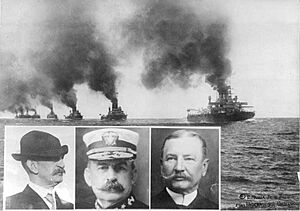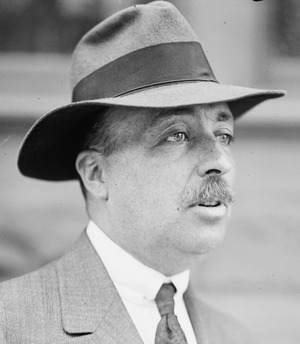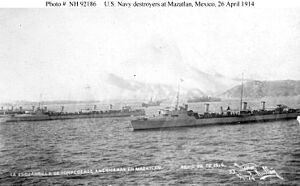Tampico Affair facts for kids
Quick facts for kids Tampico Affair |
|||||||
|---|---|---|---|---|---|---|---|
|
|||||||
| Belligerents | |||||||
| Commanders and leaders | |||||||
| Henry T. Mayo | Ignacio Morelos Zaragoza | ||||||
| Strength | |||||||
| 9 sailors | ~10 infantry | ||||||
The Tampico Affair was a small event that grew into a big problem between the United States and Mexico in 1914. It started when some U.S. Navy sailors were briefly held by Mexican soldiers in the city of Tampico. A U.S. Admiral demanded an apology and a special flag salute, but Mexico refused. This disagreement quickly grew much larger.
The conflict got worse when the Americans took over the port city of Veracruz. They stayed there for more than six months. This event helped lead to the fall of Mexico's leader, General Victoriano Huerta, who resigned in July 1914. Because the U.S. and Mexico didn't have good relations at the time, three South American countries (Argentina, Brazil, and Chile) helped try to solve the problem at a meeting in Canada. The American takeover of Veracruz made many Mexicans feel angry towards the United States.
Why the Tampico Affair Happened
Mexico's Revolution and New Leader
In 1914, Mexico was in the middle of a big fight called the Mexican Revolution. General Victoriano Huerta had taken power in Mexico. He became president after a coup, which means he took control by force, not by election. The U.S. President, Woodrow Wilson, did not agree with Huerta being in charge.
Many groups in Mexico were against Huerta. One group was led by Emiliano Zapata. Another strong group was the Constitutionalists, led by Venustiano Carranza. By March 1914, Carranza's forces were close to Tampico, a city important for its oil.
Americans in Tampico
Many American citizens lived in Tampico because U.S. companies had invested a lot in the local oil industry. To protect these Americans and their property, several U.S. Navy warships were sent to the coast. These ships were commanded by Admiral Henry T. Mayo.
Relations between the U.S. and Mexico were already tense. President Wilson had even said that there would be no peace in America until Huerta gave up his power. In early 1914, Wilson allowed the Constitutionalists to buy weapons, which showed he was thinking about getting involved.
Ships and Sailors in Tampico
Admiral Mayo's ships were in Tampico to protect American lives and businesses. His fleet included large battleships like the Connecticut and the Minnesota. They also had smaller cruisers and a gunboat called the Dolphin.
Even though Tampico was surrounded by rebel forces, the U.S. Navy and Huerta's soldiers usually got along. American sailors often went ashore to play baseball. On April 2, the U.S. gunboat Dolphin even fired a 21-gun salute to the Mexican flag as a sign of respect.
Growing Tensions
On April 6, Constitutionalist rebels took over some areas near Tampico. General Ignacio Morelos Zaragoza, who was in charge of Huerta's forces there, sent his gunboat to fight the rebels. Admiral Mayo told both sides he would stay neutral but would protect American lives and property.
Many foreign citizens, including Americans, sought safety on the U.S., German, and British ships. On April 8, a U.S. Marine messenger for the American consulate was briefly held but then released.
The next day, April 9, the U.S. gunboat Dolphin needed gasoline. Its captain, Captain Ralph Earle, arranged to buy some from a German civilian. The place where the gasoline was to be picked up was near a bridge where Mexican soldiers were stationed.
The Incident and Demands
Sailors Detained
Captain Earle sent Ensign Charles C. Copp with a small boat and crew to pick up the gasoline. The boat had U.S. flags flying, and the sailors were unarmed. They also couldn't speak Spanish.
While loading the fuel, Mexican soldiers surrounded the sailors. Even two sailors still on the boat were taken at gunpoint. All of them were taken to the local commander's headquarters. The commander released them to finish loading the gasoline but said they couldn't leave until General Zaragoza gave permission.

Inset: Appearing in the photograph (left to right): Rear Admiral Henry T. Mayo, Commander of U.S. forces during the Tampico Affair; Rear Admiral Frank F. Fletcher, who commanded the landing to seize Veracruz; Vice Admiral Charles J. Badger, Commander of U.S. Atlantic Fleet in 1914.
Mayo's Demands
The German civilian who sold the gasoline told Captain Earle and Admiral Mayo what happened. Mayo was very upset. He saw the incident as a direct insult to American honor.
Mayo demanded that Mexico formally apologize. He also wanted the Mexican officer responsible to be punished. Most importantly, he demanded that Mexico raise the American flag in a public place and salute it with 21 guns. He promised the U.S. ship would return the salute.
General Zaragoza apologized for his soldiers' actions, saying they didn't know the rules of war. The sailors were released within an hour. However, Mayo still insisted on the formal apology and flag salute.
Huerta Refuses
General Zaragoza sent Mayo's demands to Mexico City. When President Wilson heard about it, he fully supported Admiral Mayo. He said that if the people responsible were not punished, there could be serious problems.
Mexico's foreign relations minister told the American representative in Mexico City, Nelson J. O'Shaughnessy, that Mayo's demands should be dropped. He said Zaragoza had already apologized. Huerta agreed. O'Shaughnessy then mistakenly told the news that U.S. Marines (not sailors) had been "paraded" through the streets, making the incident seem worse.
On April 12, Huerta said that since Zaragoza had apologized and arrested the officer involved, the U.S. had received enough satisfaction. He refused to apologize further or salute the American flag. Huerta said these demands were "humiliating" and would make Mexico seem less important. O'Shaughnessy warned that Wilson might use force if needed.
Wilson's Response
On April 13, President Wilson told reporters, "The salute will be fired." On April 14, he ordered the U.S. Atlantic Fleet to Mexican waters. Huerta seemed to welcome the idea, saying it was "the best thing that could happen to us."
Wilson felt that Mexico had often disrespected American rights and dignity without making things right. On April 16, Mexico seemed to agree to a "simultaneous salute," meaning both flags would be saluted at the same time. However, Wilson misunderstood this. When he finally understood, he rejected the idea.
Wilson insisted that Mexico must fire the salute by the next day. If not, he would ask Congress for permission to use armed force to make Mexico respect the U.S. flag.
What Happened Next
Veracruz Occupation
On April 20, Wilson asked Congress for permission to use armed forces. He specifically wanted to take Veracruz to remove Huerta from power. Congress approved his request that evening. Wilson then ordered U.S. forces to land in Veracruz to seize the customs house and stop a shipment of weapons meant for Huerta's army.
During the United States occupation of Veracruz, 19 Americans were killed and 72 were wounded. Many Mexican soldiers and civilians also died or were injured.
Impact on Americans in Mexico
On Mexico's Pacific coast, U.S. Navy ships watched the fighting and protected American citizens. In some cities, anti-American protests broke out. For example, in Ensenada, the U.S. consul and 250 Americans had to hide in the consulate building. U.S. warships were sent to evacuate them.
The invasion of Veracruz affected about 50,000 U.S. citizens living in Mexico. Refugee camps were set up in the U.S. to help them. Many U.S. Navy ships helped pick up American refugees from various Mexican ports. By May 4, 1914, 71 U.S. Navy ships were operating in Mexican waters.
Long-Term Effects
The Tampico incident and the Veracruz occupation caused strong anti-American feelings in Mexico. This was a main reason why Mexico chose to stay neutral during World War I. Mexico refused to join the U.S. military in Europe and allowed German companies to continue operating in Mexico City.
Later, in 1917–1918, President Wilson thought about invading Veracruz and Tampico again. He wanted to control important oil fields and a short land route between the Atlantic and Pacific oceans. However, Mexico's new president, Venustiano Carranza, threatened to destroy the oil fields if U.S. Marines landed there, so the invasion didn't happen.
|
See also
 In Spanish: Incidente de Tampico para niños
In Spanish: Incidente de Tampico para niños



